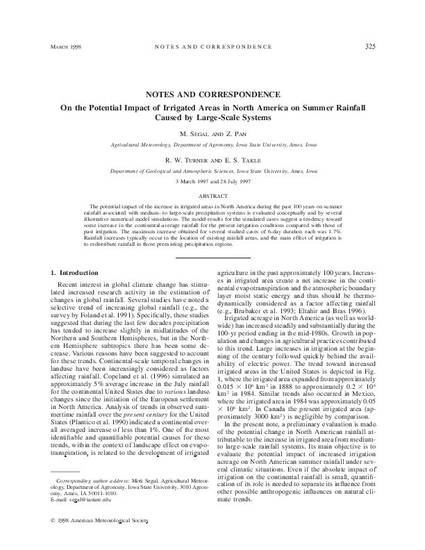
Article
On the Potential Impact of Irrigated Areas in North America on Summer Rainfall Caused by Large-Scale Systems
Journal of Applied Meteorology and Climatology
Document Type
Article
Disciplines
Publication Version
Published Version
Publication Date
3-1-1998
DOI
10.1175/1520-0450-37.3.325
Abstract
The potential impact of the increase in irrigated areas in North America during the past 100 years on summer rainfall associated with medium- to large-scale precipitation systems is evaluated conceptually and by several illustrative numerical model simulations. The model results for the simulated cases suggest a tendency toward some increase in the continental-average rainfall for the present irrigation conditions compared with those of past irrigation. The maximum increase obtained for several studied cases of 6-day duration each was 1.7%. Rainfall increases typically occur in the location of existing rainfall areas, and the main effect of irrigation is to redistribute rainfall in those preexisting precipitation regions.
Copyright Owner
American Meteorological Society
Copyright Date
1998
Language
en
File Format
application/pdf
Citation Information
Moti Segal, Zaitao Pan, R. W. Turner and Eugene S. Takle. "On the Potential Impact of Irrigated Areas in North America on Summer Rainfall Caused by Large-Scale Systems" Journal of Applied Meteorology and Climatology Vol. 37 Iss. 3 (1998) p. 325 - 331 Available at: http://works.bepress.com/eugene-takle/92/

This article is published as Segal, M., Z. Pan, R. W. Turner, and E. S. Takle. "On the potential impact of irrigated areas in North America on summer rainfall caused by large-scale systems." Journal of Applied Meteorology 37, no. 3 (1998): 325-331. DOI:10.1175/1520-0450-37.3.325. Posted with permission.